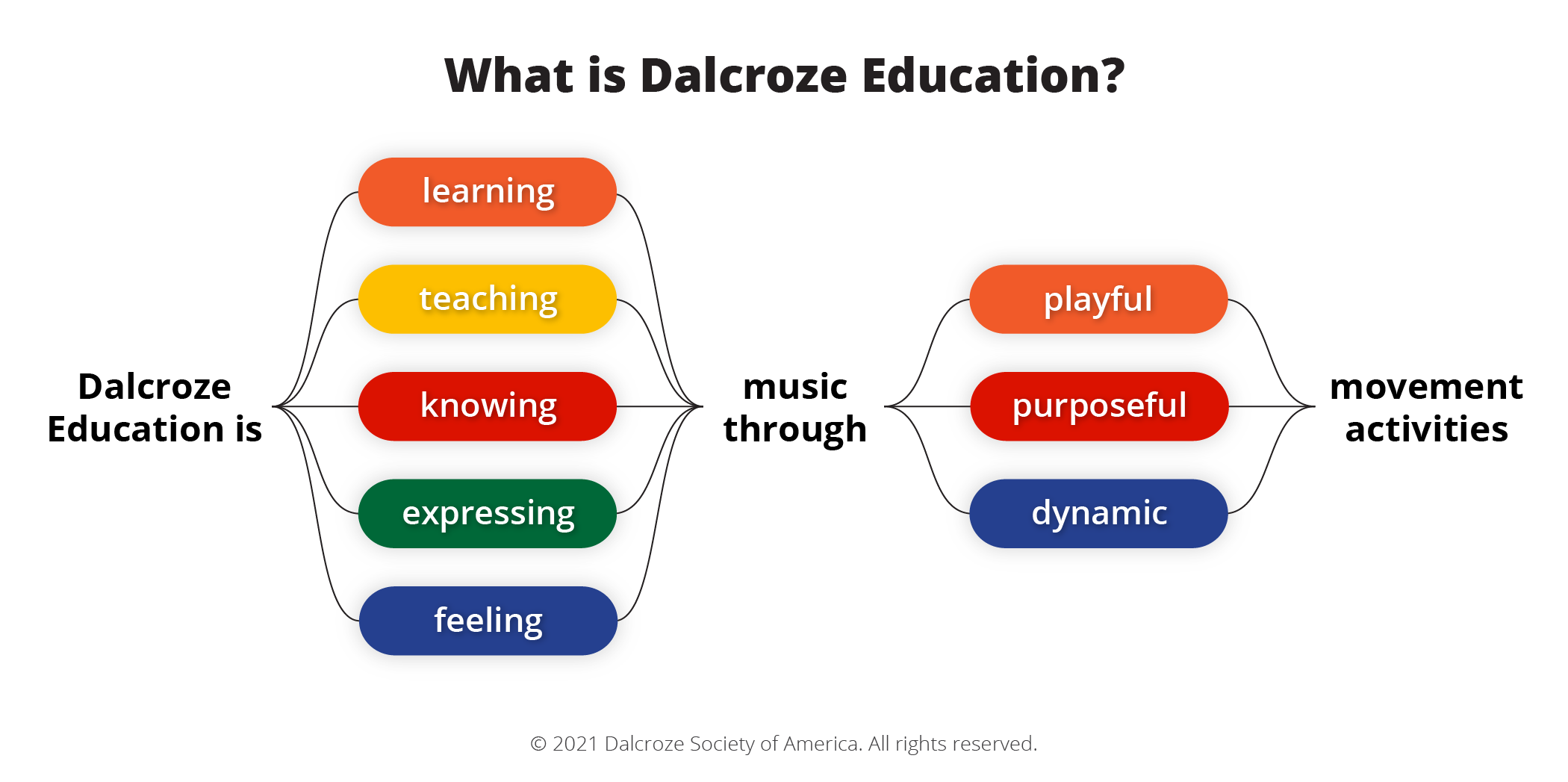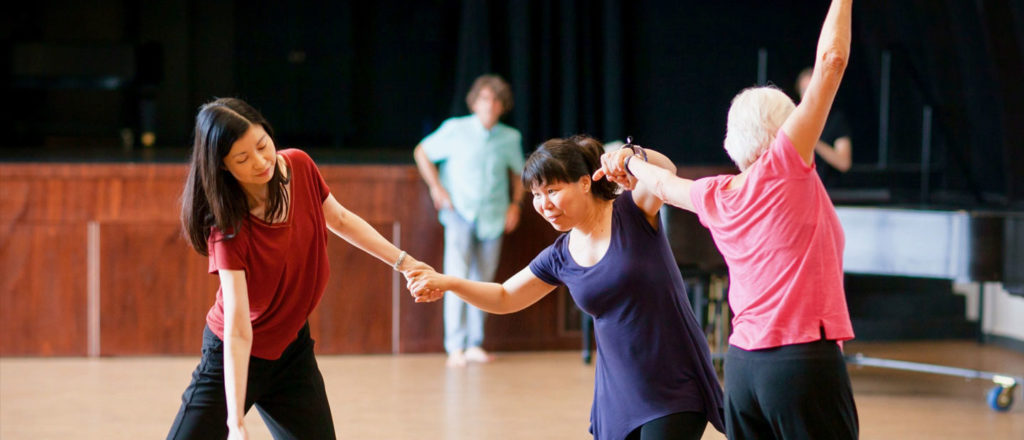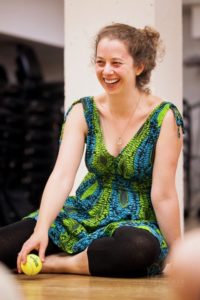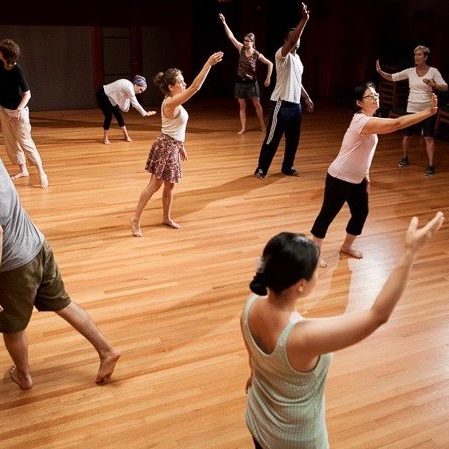What is Dalcroze?
Learn what Dalcroze Education is and what makes it an essential part of the musical awakening of students around the world. The benefits apply to more than just musicians. What does a Dalcroze class look like?

Why Dalcroze?
Dalcroze Education is a playful, experiential approach to teaching and learning music. It is a process for awakening, developing, and refining innate musicality through rhythmic movement (often called eurhythmics), ear-training, and improvisation.

Lisa Parker teaches her students the importance of space while using a drum.
This unique approach to musical learning makes music vivid for everyone, from young beginners through adult professionals. When experiencing a Dalcroze class, you begin to feel, express, and master the flow that is essential to music, dance, and the other performing arts.
Dalcroze Education has been around for more than a century. The method was developed starting in 1886 by Émile Jaques-Dalcroze, a Swiss composer and educator. It features interactive games and exercises that help students learn to trust their ideas and develop their own intuitions. Today, his ideas about education have been confirmed by scientific research.
Dalcroze Education is a rich, complex, multifaceted practice that encourages each of us to experience it on our own terms, as individuals. Each participant can define it differently, through the lens of their own experience.
Ready to experience it for yourself?
Lisa Parker (Director Emeritus of the Dalcroze Eurhythmics program at the Longy School of Music) discusses Dalcroze goals and benefits through a lesson on measure shape.
Benefits of Dalcroze Education
The Dalcroze approach can provide benefits for:
- Performers
- Teachers
- Dancers
- Actors
- Young children
- Seniors
- People with disabilities or special needs
Dalcroze Education is a key part of the curriculum at leading institutions, K-12 to collegiate, around the world. It is so intuitive, from an early age children in Dalcroze classes develop critical listening, motor, and social skills without even know they’re learning. Yet it can also inspire musicians to reach for higher levels of performance in their professional development.
No matter what level of training you bring to Dalcroze, you can deepen your musical understanding and improve your body awareness.
For musicians:
- Develop a stronger sense of rhythm and harmony
- Unlock easier, more expressive performance
- Heighten listening skills and intuition
- Understand music through the body
For dancers:
- Refine non-verbal expression
- Learn essential musical concepts
- Encourage aesthetic development
For seniors:
- Improve coordination and balance
- Enhance cognitive skills
- Strengthen memory function
Experience musical concepts in a playful manner and use your entire body as a musical instrument. When paired with private music lessons, Dalcroze Education promotes deep learning in all musicians.
Scientific research supports many of the benefits experienced by participants. The Dalcroze method has even been applied to many diverse fields, including music therapy, team building, and in mitigating the negative effects of aging.
A Dalcroze Eurhythmics Class
In a Dalcroze Eurhythmics class, students are moving in some way: in traveling around the room, or in gestures with hands, arms, heads, or upper bodies. Their movements are responsive to the music in the room. The teacher is probably improvising this music at the piano or on another instrument. (Sometimes recorded or composed music is used.)
The task is typically to move in space using certain guidelines, specific to the musical piece. For example, the teacher may ask the students to walk around the room, stepping the beat. Then, when the students hear a specific cue, they should clap the beat instead. The game continues, with the students challenged to find new ways to express the beat with their body.
The teacher shapes the music not only to the rules of the task, but to what they observe the students doing. The students, in turn, shape their accomplishment of the task to the nature of the music – its tempo, dynamics, texture, phrase structure, and style. Change is a constant in each lesson.

Dalcroze call on us to use expressive gestures to give shape to music.
Dalcroze Education is divided into three main categories:
- Eurhythmics engages the body in rhythmic movement and active listening
- Solfège develops internal melody and harmony, along with a holistic response to musical notation
- Improvisation brings out the creative spirit with the voice, an instrument, or the body
In a Dalcroze class, the instructor combines these elements through rhythm games, songs, gesture, and movement.
 Certified Dalcroze teachers work in conservatories, universities, public and private schools, early childhood programs, and private studios. Due to the intensive training process and the many sophisticated skills required to be a Dalcroze educator, the number of certified teachers remains small but their impact on music education is significant.
Certified Dalcroze teachers work in conservatories, universities, public and private schools, early childhood programs, and private studios. Due to the intensive training process and the many sophisticated skills required to be a Dalcroze educator, the number of certified teachers remains small but their impact on music education is significant.
No Dalcroze educator is alike and no class is like any other. The Dalcroze approach allows for incredible variety in teaching styles and methods. There are many different and unique ways that Dalcroze educators have used this approach to lead students to discover how they can embody music.
Online Publications from Dalcroze USA
How do in-person Dalcroze classes compare to online classes?
Online Publications from Dalcroze USA
Further Reading
• How Dalcroze Eurhythmics Has Transformed my Solfège and Ear Training Teaching (Margarita Martínez Mejía)
• Are You Familiar with the T2 Program? (Jeremy Dittus)
• Quick Reactions with a Dalcroze Teacher (Michael Joviala)


